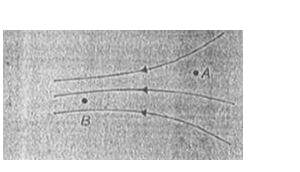When a charge is carried from point A to point B, the amount of work done by the electric field is . What is the potential difference and which point is at a higher potential ?
both are at same potential.
The correct Answer is:b
To solve the problem, we need to find the potential difference between points A and B when a charge is moved from A to B, and determine which point is at a higher potential.
1. Identify the Given Values:
- Charge (Q) = 2 µC = 2×10−6 C
- Work done (W) = 50 µJ = 50×10−6 J
2. Use the Formula for Potential Difference:
The potential difference (V) between two points A and B is given by the formula:
VAB=VA−VB=WABQ
where WAB is the work done in moving the charge from point A to point B.
3. Substitute the Values into the Formula:
VAB=50×10−6 J2×10−6 C
4. Calculate the Potential Difference:
VAB=502=25 V
5. Determine Which Point is at Higher Potential:
Since the work done by the electric field is positive (50 µJ), it indicates that the charge is moving from a point of higher potential (A) to a point of lower potential (B). Therefore, point A is at a higher potential than point B.
Final Answer:
- The potential difference VAB is 25 V.
- Point A is at a higher potential than point B.
- Charge (Q) = 2 µC = 2×10−6 C
- Work done (W) = 50 µJ = 50×10−6 J
The potential difference (V) between two points A and B is given by the formula:
VAB=VA−VB=WABQ
where WAB is the work done in moving the charge from point A to point B.
VAB=50×10−6 J2×10−6 C
VAB=502=25 V
Since the work done by the electric field is positive (50 µJ), it indicates that the charge is moving from a point of higher potential (A) to a point of lower potential (B). Therefore, point A is at a higher potential than point B.
- The potential difference VAB is 25 V.
- Point A is at a higher potential than point B.
Topper's Solved these Questions
- BOOK - CENGAGE PHYSICS ENGLISHCHAPTER - ELECTRIC POTENTIALEXERCISE - Multiple Correct10videos
ELECTRIC POTENTIAL
- BOOK - CENGAGE PHYSICS ENGLISHCHAPTER - ELECTRIC POTENTIALEXERCISE - Comprehension31videos
ELECTRIC POTENTIAL
- BOOK - CENGAGE PHYSICS ENGLISHCHAPTER - ELECTRIC POTENTIALEXERCISE - Subjective28videos
ELECTRIC POTENTIAL
- BOOK - CENGAGE PHYSICS ENGLISHCHAPTER - ELECTRIC FLUX AND GAUSS LAWEXERCISE - MCQ s38videos
ELECTRIC FLUX AND GAUSS LAW
- BOOK - CENGAGE PHYSICS ENGLISHCHAPTER - ELECTRICAL MEASURING INSTRUMENTSEXERCISE - M.C.Q2videos
ELECTRICAL MEASURING INSTRUMENTS
Similar Questions
A point charge is taken from a point A to a pint B in an electric field. Does the work done by the electric field depend on the path of the charge ?
View SolutionWhat amount of work of work in needed in moving 2C Charge through a potential difference of 8V.
View SolutionThe work done in carrying a charge of 5μC form a point A to a point B in an electric field is 10mJ. The potential difference (VB−VA) is then
View SolutionThe amount of work done in moving a charge of 5 C across two points having a potential difference of 15 Volts is equal to
View SolutionShow that the electric field at any point is equal to negative potential gradient at the point.
View SolutionShow that the electric field at any point is equal to negative potential gradient at the point.
View SolutionA charge of 10C is moved in an electric field of a fixed charge distribution from point A to another point B slowly. The work done by external agent in doing so is 100J. What is the potential difference VA−VB?
View SolutionA charge is moved in an electric field of a fixed charge distribution from point A to another point B slowly. The work done by external agent in doing so is 100J. What is the change in potential energy of the charge as it moves from A to B ? What is the work done by the electric field of the charge distribution as the charge moves from A to B ?
View SolutionA charge is moved in an electric field of a fixed charge distribution from point A to another point B slowly. The work done by external agent in doing so is 100J . What is the change in potential energy of the charge as it moves from A to B ? What is the work done by the electric field of the charge distribution as the charge moves from A to B ?
View SolutionIn figure two points A and B are located in a region of electric field . The potential difference VB−VA is
 View Solution
View Solution

